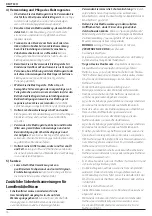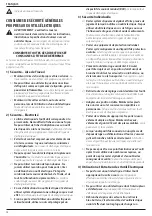
27
EngLIsh
Assembling the Workpieces
1. Try assembling the workpieces together to check that the
joints fit correctly.
2. Evenly spread a suitable glue in the biscuit slots and on the
mating surfaces of the joint.
3. Insert the biscuits into the slots, ensuring that they come
into contact with the glue.
4. Assemble the workpieces and clamp them until the glue
has dried.
Edge to Edge Joints (Fig. O1, O2)
1. Place the workpieces on a flat surface as they are to
be assembled.
2. Mark the biscuit centres. The biscuits should be located at
15–25 cm intervals; the outer biscuits should be located
5–7.5 cm from the ends of the workpiece (Fig. O1).
3. Set the fence to 90 °.
4. Set the height adjuster to position the biscuit in the centre
of the workpiece.
5. Adjust the other tool settings as described above.
6. Cut the biscuit slots as described above (Fig. O2).
Frame Joints (Fig. P1–P3)
1. Place the workpieces on a flat surface as they are to be
assembled (Fig. P1, P2).
2. Select the appropriate biscuit size.
3. Mark the biscuit centres.
4. Adjust the tool settings as described above.
5. Cut the biscuit slots as described above (Fig. P3).
Corner Joints (Fig. Q1, Q2)
1. Arrange the workpieces as they are to be assembled
(Fig. Q1).
2. Select the appropriate biscuit size.
3. Mark the biscuit centres.
4. For the face cut, clamp the workpiece and align the tool as
shown (Fig. Q2)
5. Cut the biscuit slots as described above.
Offset Joints (Fig. R)
When joining two workpieces of different thickness, proceed
as follows:
1. Arrange the workpieces as they are to be assembled.
2. Select the appropriate biscuit size.
3. Mark the biscuit centres.
4. Select the workpiece that will be set back.
5. Set the height adjuster to position the biscuit in the centre
of the workpiece.
6. Cut the biscuit slots as described above.
7. Adjust the fence up by a distance equal to the desired offset.
Use the scale to read the setting.
8. Cut the biscuit slots as described above.
Locating the Biscuits (Fig. M1–M4)
For edge joints, biscuits should normally be located at 15–25 cm
intervals.The outer biscuits should be located 5–7.5 cm from the
ends of the workpiece (Fig. M1).
When joining narrow workpieces such as picture frames, even
the smallest biscuits may be too large for the joint. In this case,
the exposed tip of the biscuit should be trimmed off after the
joint has been glued (Fig. M2).
When joining workpieces thicker than approx. 2.5 cm, pairs of
biscuits may be used for additional strength (Fig. M3).
To mark mating pieces, first position them as they will be
assembled. Use a set square to draw the marking line across the
pieces (Fig. M4).
Cutting Biscuit Slots (Fig. N)
1. Adjust the tool settings as described above.
2. Align the centre marking on the tool base with the marking
line as shown.
3. Switch the tool on and wait a second for the cutter attain
full speed.
4. Firmly push the fence against the workpiece and plunge the
cutter until the stop is reached.
5. Allow the tool to retract the blade from the workpiece.
6. Turn the tool off.
Making Biscuit Joints (Fig. K–N)
WARNING:
Always make a trial cut in a piece of
scrap wood to check the plunge depth. If necessary,
perform a fine adjustment as described in
Assembly
& Adjustments
.
Various techniques can be used to make strong and accurate
biscuit joints. In this manual, the most important techniques will
be discussed in more detail (Fig. K).
Selecting the Biscuit Size (Fig. L)
The three biscuit sizes are #0, #10 and #20. Normally, you should
use the largest biscuit that will fit in the workpiece.
After selecting the size of biscuit to be used, adjust the
plunge depth accordingly as described under
Plunge
Depth Adjustment
.
Switching On and Off (Fig. B)
WARNING:
Do not switch the tool on or off when the
blade touches the workpiece or other materials.
1. To run the tool, press the On/Off switch
1
.
2. If necessary, press the lock-on button
2
for continuous
operation and release the switch.
3. To stop the tool, release the switch.
4. To stop the tool in continuous operation, press the switch
briefly and release it. Always switch the tool off when work is
finished and before unplugging.
WARNING:
To reduce the risk of serious personal
injury,
ALWAYS
hold securely in anticipation of a
sudden reaction.
Proper hand position requires one hand on the top handle
3
,
with the other hand on the main grip
16
.
Содержание DW682
Страница 1: ...DW682 ...
Страница 3: ...1 Fig A 3 4 10 9 5 17 2 8 7 11 6 1 ...
Страница 4: ...2 Fig B Fig C1 Fig C2 Fig D Fig E Fig F Fig G Fig H 2 1 11 6 9 4 8 6 7 12 ...
Страница 5: ...3 0 10 20 15 25 cm 5 7 5 cm Fig I Fig J1 Fig J2 Fig K Fig M2 Fig M3 Fig L Fig M1 5 14 15 13 5 10 ...
Страница 6: ...4 5 7 5 cm 15 25 cm 15 25 cm Fig M4 Fig N Fig O1 Fig O2 Fig P1 Fig P2 Fig P3 Fig Q1 ...
Страница 7: ...5 Fig Q2 Fig R Fig S1 Fig S2 Fig T1 Fig T2 Fig S3 Fig S4 ...
Страница 8: ...6 Fig T3 Fig T4 Fig T5 Fig U 3 16 ...
Страница 106: ......
Страница 107: ......
















































